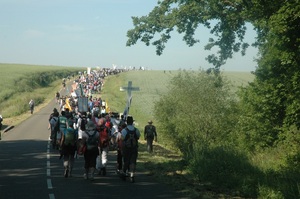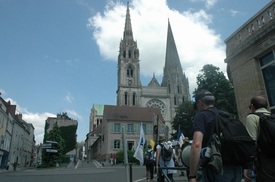 Salt + Light TV has given a wonderful gift in doing a terrific story on the ancient pilgrimage trail called in Spanish, El Camino de Santiago. The Way of Saint James. Alessia Domanico is the host of “Discovering the Way: El Camino de Santiago.”
Salt + Light TV has given a wonderful gift in doing a terrific story on the ancient pilgrimage trail called in Spanish, El Camino de Santiago. The Way of Saint James. Alessia Domanico is the host of “Discovering the Way: El Camino de Santiago.”
I’ve been wanting to walk the Camino for years. I can think of no other pilgrimage to do with gusto than this one. It may still take me time to plan and go on the Way of Saint James, but I am resolved. You???
As was said in the video, the walk along the long trail to tomb of Saint James does many things but for me it seems to me that its most important aspect is one’s ability to notice beauty, to notice life. Recall that beauty is that theological datum that most speaks of God in a most authentically human and spiritual manner.
The Camino is truly about the Christian tradition, there’s:
- a great adventure, go for a purpose: you’ll grow spiritually and physically
- an opportunity to pray, to do penance, to be reminded of tradition
- catechesis on the faith
- an opportunity to learn Christian and civil history
- to know your own humanity, that of the other
- learn and experience the christian faith
- have the goal to go to the Cathedral of Saint James to visit the relics of a great Apostle.
I would also recommend Monsignor Kevin A. Codd’s book on the making the pilgrimage,
To the Field of Stars.
 Salt + Light TV has given a wonderful gift in doing a terrific story on the ancient pilgrimage trail called in Spanish, El Camino de Santiago. The Way of Saint James. Alessia Domanico is the host of “Discovering the Way: El Camino de Santiago.”
Salt + Light TV has given a wonderful gift in doing a terrific story on the ancient pilgrimage trail called in Spanish, El Camino de Santiago. The Way of Saint James. Alessia Domanico is the host of “Discovering the Way: El Camino de Santiago.”
